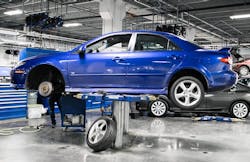When was the last time you had your lift inspected? Be honest. If you said within the past year with a certified inspector, you’ve passed the first test. Now, here’s a trickier one. How many of you can say with 100 percent certainty that everyone that operates a lift does so in the safest way possible and according to the guidelines provided by the manufacturer?
A shortcut made by a seasoned technician who has used the lift hundreds of times could result in an injury. When it comes to the safety of your employees, that’s too much of a risk for you to take. Not only that, but a lift that isn’t up to code can result in a costly fine. So, rather than getting a fine that could have been avoided—or worse—having someone injured on the job, take the time to make sure your lift is up to code and used properly. It’s as simple as a few precautions.
David Fischmer, director of marketing for the Vehicle Service Group (which includes Rotary Lift) shares how shop owners can ensure lifts are well-maintained and used in a safe way.
As told to Tess Collins
It’s far too common that lifts are used in an unsafe manner. While lift injuries themselves are not all that common, they do happen and can—and should—be avoided. Lifts are similar to other pieces of equipment in the fact that issues can arise if they are not used in the way that they were designed. This is an easy issue to solve.
Getting your technicians trained on how to use lift properly is key. During training, they will learn that they always need to lift up by the vehicle’s recommended pickup points, for example. They will also learn the correct way to load a lift, how to spot and lift a vehicle and when to use accessories like auxiliary adapters or jack stands.
Lift operational training can come from a variety of resources. If you’re just getting a lift, getting a demo and hands-on-training from the lift distributor is key. They’ll be able to show you and your employees how to position and operate the lift, as well as give reminders about weight limits. More in-depth training is available from the Automotive Lift Institute (ALI). ALI’s “Lifting it Right” training course is available on their website autolift.org and can be purchased for individual technicians or entire shops.
When you’re in the business of working on vehicles, safety is always a concern—both for the techs who work on the cars or trucks and the people who drive them. Well-trained technicians tend to work safer. They have a deeper understanding of the vehicles they work on.
Once they’ve been trained, they need to continue best practices. Every time a tech uses the lift, they should follow safe-usage guidelines. Most lifts are easy enough to operate that techs may not forget how to use them correctly, but they might be tempted to take shortcuts or push the limits. Reminders about safety are a good idea. Post signage about positioning and weight limits in places where techs will see them regularly [See Breakout Box: Rotary’s Operational Lift Checklist].
Operational Lift Checklist
A daily reminder can ensure costly accidents don't happen
David Fischmer, director of marketing for the Vehicle Service Group, shared this operational checklist with Ratchet+Wrench that shop owners can post near lifts as a reminder on proper procedures.
Inspect each lift prior to operation daily.
Check cables and sheaves for wear daily. Wipe cables with a rag to detect hard-to-see small broken strands. Replace cables showing any broken wires, severe corrosion, excessive stretch, deformed strands, variations in diameter or any change in normal appearance.
Periodically check the anchor bolts that attach the lift to the floor. Make sure they are tight in accordance with manufacturer guidelines.
Lubricate the lift per manufacturer’s guidelines.
On hydraulic lifts, check the fluid level and quality regularly and refill/replace it as needed.
Always keep lift components clean and free of corrosive agents, solvents and road de-icing chemicals. If such materials come in contact with lift components, immediately rinse the area thoroughly with water and wipe down with a clean rag.
Inspect lift adapters and accessories, like rolling jacks, regularly.
Replace any damaged or missing caution, warning or safety-related decals on the lift.
Schedule annual lift inspections with a qualified lift inspector.
Beyond training and proper procedures, the actual lift needs to be checked. All shops should have their vehicle lifts inspected annually by a qualified ALI inspector. Lifts are a big financial investment and lift inspections are one of the easiest ways to protect that investment and ensure that all of the lift’s safety and performance mechanisms are working properly.
The American National Standards Institute (ANSI) covering lift operation, maintenance and inspection and a growing number of state codes and regulations require annual lift inspections. Plus, documented annual lift inspections can help prevent Occupational Safety and Health Administration (OSHA) citations and fines.

